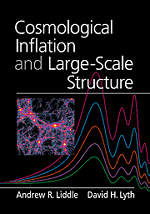Book contents
- Frontmatter
- Contents
- Frequently used symbols
- Preface
- 1 INTRODUCTION
- 2 THE HOT BIG BANG COSMOLOGY
- 3 INFLATION
- 4 SIMPLEST MODEL FOR THE ORIGIN OF STRUCTURE I
- 5 SIMPLEST MODEL FOR THE ORIGIN OF STRUCTURE II
- 6 EXTENSIONS TO THE SIMPLEST MODEL
- 7 SCALAR FIELDS AND THE VACUUM FLUCTUATION
- 8 BUILDING AND TESTING MODELS OF INFLATION
- 9 THE COSMIC MICROWAVE BACKGROUND
- 10 GALAXY MOTIONS AND CLUSTERING
- 11 THE QUASI-LINEAR REGIME
- 12 PUTTING OBSERVATIONS TOGETHER
- 13 OUTLOOK FOR THE FUTURE
- 14 ADVANCED TOPIC: COSMOLOGICAL PERTURBATION THEORY
- 15 ADVANCED TOPIC: DIFFUSION AND FREESTREAMING
- Appendix: Constants and parameters
- Numerical solutions and hints for selected examples
- References
- Index
2 - THE HOT BIG BANG COSMOLOGY
Published online by Cambridge University Press: 05 June 2012
- Frontmatter
- Contents
- Frequently used symbols
- Preface
- 1 INTRODUCTION
- 2 THE HOT BIG BANG COSMOLOGY
- 3 INFLATION
- 4 SIMPLEST MODEL FOR THE ORIGIN OF STRUCTURE I
- 5 SIMPLEST MODEL FOR THE ORIGIN OF STRUCTURE II
- 6 EXTENSIONS TO THE SIMPLEST MODEL
- 7 SCALAR FIELDS AND THE VACUUM FLUCTUATION
- 8 BUILDING AND TESTING MODELS OF INFLATION
- 9 THE COSMIC MICROWAVE BACKGROUND
- 10 GALAXY MOTIONS AND CLUSTERING
- 11 THE QUASI-LINEAR REGIME
- 12 PUTTING OBSERVATIONS TOGETHER
- 13 OUTLOOK FOR THE FUTURE
- 14 ADVANCED TOPIC: COSMOLOGICAL PERTURBATION THEORY
- 15 ADVANCED TOPIC: DIFFUSION AND FREESTREAMING
- Appendix: Constants and parameters
- Numerical solutions and hints for selected examples
- References
- Index
Summary
The central premise of modern cosmology is that, at least on large scales, the Universe is homogeneous and isotropic. This is borne out by a variety of observations, most spectacularly the nearly identical temperature of microwave background radiation coming from different parts of the sky. Despite the belief in homogeneity on large scales, it is all too apparent that in nearby regions the Universe is highly inhomogeneous, with material clumped into stars, galaxies, and galaxy clusters. It is believed that these irregularities have grown over time, through gravitational attraction, from a distribution that was more homogeneous in the past.
It is convenient then to break up the dynamics of the Universe into two parts. The largescale behaviour of the Universe can be described by assuming a homogeneous and isotropic background. On this background, we can superimpose the short-scale irregularities. For much of the evolution of the Universe, these irregularities can be considered to be small perturbations on the evolution of the background Universe, and can be tackled using linear perturbation theory; we discuss this extensively, starting in Chapter 4. It is also possible to continue beyond the realm of linear perturbation theory, via a range of analytic and numerical techniques, which we discuss only briefly, in Chapter 11. In this chapter and the next, we concern ourselves solely with the evolution of the background, isotropic Universe. This usually is called the Robertson Walker Universe, often with Friedmann and occasionally with Lemaitre also named.
- Type
- Chapter
- Information
- Cosmological Inflation and Large-Scale Structure , pp. 12 - 35Publisher: Cambridge University PressPrint publication year: 2000



